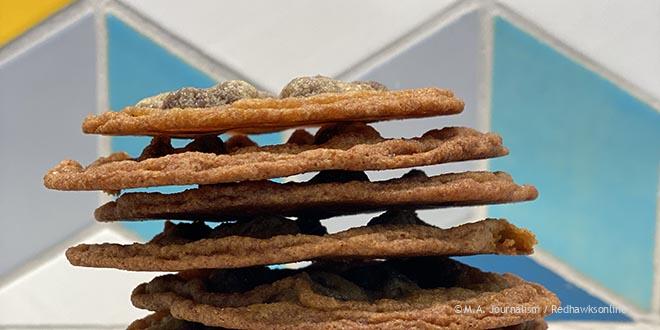The art of chocolate chip cookies
Learn how to make the cookies, using science
Chocolate chip cookies: an American classic that is a staple in everyone’s kitchen. Some people like them with melty, ooey-gooey chocolate. Not everyone likes them this same way so here is how to make the chocolate chip cookie you love – with science!
“My ultimate chocolate chip cookie has dark chocolate in it, it’s a little bit chewy, not like crispy,” said science teacher Joy Reist, “and I like it with a little bit of salt, because it brings out the flavor of the chocolate, kind of like a salted dark chocolate.”
As someone who teaches science and takes detailed notes, Carmella Whaley has a very specific cookie in mind.
“My ultimate delicious chocolate chip cookie would be very chocolatey, it would be thick,” Whaley said. “It would be maybe a couple centimeters high and it would have some chopped pecans in it. It would have a secret ingredient which is espresso powder. So you don’t really taste the coffee in your chocolate cookie but there is something there that helps bring out the chocolate flavor and makes it stronger.”
The main ingredients when making cookies are flour, fat, liquid, sugar, salt, chocolate and baking soda or powder. These components all have a special purpose.
Flour has many different varieties. All of them have different protein levels, according to the book, BakeWise by Shirley Corriher. Flour also helps provide structure for the dough.
“Flour adds protein…So the more high protein you have, the more structure there would be. So it would be a crispier cookie or harder,” said Whaley.
“Cake flour has lower-protein. It’s way more fluffy, not as stiff,” said Reist. Cake flour is used in the fluffy and cakey cookies below.
Fat also comes in different forms but is usually butter. Fat helps put moisture into the cookie and makes the cookie tender.
The liquid is usually eggs in cookie dough, but could also be milk or water. Eggs “provide the protein that gives the cookie the structure,” said Whaley.
The sugar helps give the cookie a nice golden brown texture and caramelization.
“In my family, we do double the amount of brown sugar versus white because brown sugar has molasses added back into it,” said Reist, “so it makes it have more moisture and be chewier overall.”
White sugar makes cookies crispier. According to the book On Food and Cooking written by Harold McGee, “Sucrose [white sugar] makes crispier cookies because the sugar melts when in the oven then recrystallizes to have a shape.”
Salt is in all of the food that we eat everyday.
“The salt brings out the flavor of the chocolate so that [the cookie] tastes better,” said Whaley.
Chocolate is a very easily customizable ingredient. Choose a chocolate that you like or even a combination of two different types. Also, you could use chocolate chunks versus chocolate chips, it depends on your preference.
The baking powder and baking soda are necessary for all cookies because they are used as a leavening agent.
“Baking soda is just made up of sodium bicarbonate, which needs to react with an acid in order to create CO2 gas,” said Reist. “Baking powder on the other hand has some acids added in, which allows it to make CO2 at different times than the baking powder. To my understanding, there are two added acids in baking powder. One reacts with baking powder when a liquid is introduced to the mixture and the other reacts with baking powder when it is heated in the oven.”
She also explained that baking soda will make a crispier cookie.
Below are the recipes to make cookies thin and chewy but also fluffy and cakey. Cookies are very versatile. If you are looking for a quick treat, then learning about the science behind these cookies will help you create the perfect snack.

